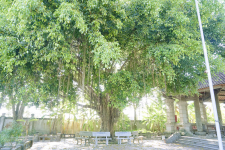
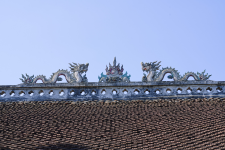
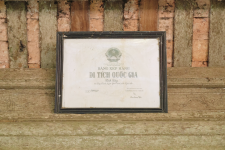
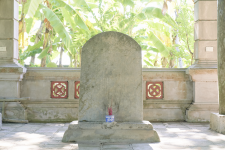
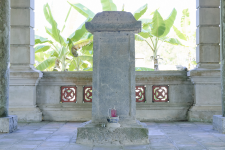
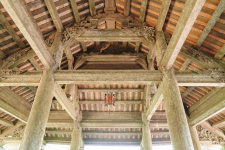
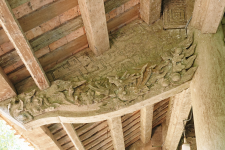
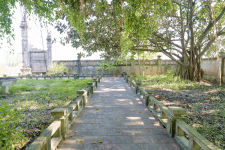
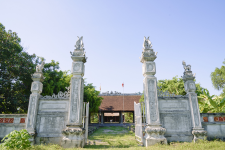
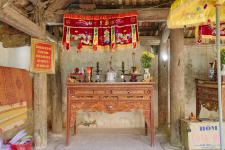
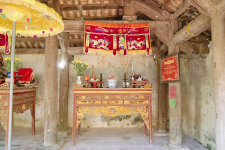
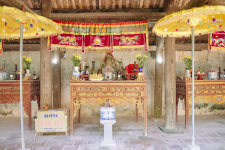
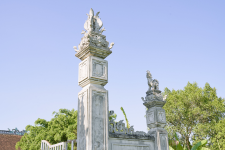
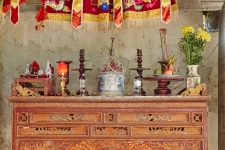
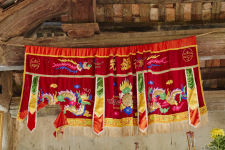
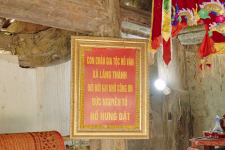
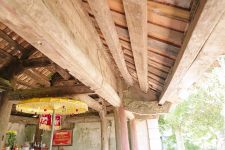

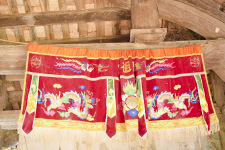

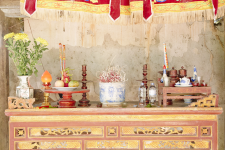
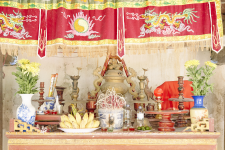
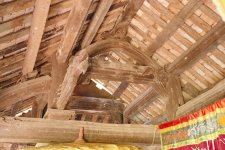
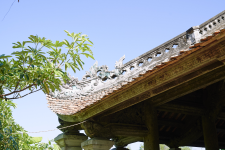
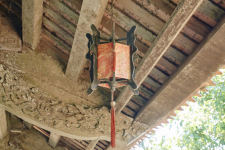
Camera tour
Price: Free
Time to visit a place: 120 phút
Open Time: 7:00 AM - Close Time: 6:00 PM
Address: Lang Thanh Village, Yen Thanh District, Nghe An Province
SUNG COMMUNAL HOUSE – YEN THANH DISTRICT
Coming to Quy Lang ancient village, now known as Lang Thanh commune, Yen Thanh district, Nghe An province, visitors cannot help but visit the 500-year-old ancient Sung communal house in the middle of the field, famous as a communal house with the most typical artistic architecture in Nghe An.
Sung communal house was built in November 1583 to worship the tutelary god of Cao Son - Cao Cac and to serve the needs of cultural, religious and spiritual activities, as well as the meeting place of the villagers.
The tutelary gods of Cao Son - Cao Cac are popularly worshiped in Nghe province, are the deities who have merit to protect the nation and protect the people, and have been ordained many times by feudal dynasties. There are many legends, many different versions of these gods, some are considered one god, some are considered two gods. In the land of Ke Sung, people believe that Cao Son, whose real name is Cao Hien, is a Tong Dynasty mandarin, who came to guard Annam, wholeheartedly for the people's life. After his death, he was conferred the title of "Great King An Nam" by King of the Tong Dynasty, assigned to the people of An Nam to set up a temple to worship, he often inspired, protected and maintained for the people. Cao Cac was a native of Tho Xuan, Thanh Do (now known as Thanh Hoa), he had the merit of following Dinh Bo Linh, helping the king to defeat the enemy, and founding the Dinh dynasty. After his death, the Court built a temple to worship, King Ly Thai To bestowed the title "Great King".
In the past, Sung communal house was made of bamboo and bamboo leaves. In 1797, people built more harem house to worship the village's tutelary god. The communal house was repaired many times, until 1929, the communal house was restored on a massive scale with an extremely unique and impressive Nguyen Dynasty architectural and art style with the items of main-hall, harems and shrine.
The main-hall of communal house is large with a length of 24.7m, a width of 11.2m, 5 compartments, 2 gables, 24 columns made of ironwood that are supported on stone pillars, with 6 sets of gong-style trusses. Ancient artisans have shown elaborate and sophisticated decorative arts, sculpting and carving techniques on architectural parts such as the roof bank, beams, and trusses in the temple. The decoration topics around the theme of the four sacred animals and four kinds of trees are arranged in a harmonious and balanced manner. The most outstanding feature is the 4 carvings on 4 paintings in 4 corners of the main-hall, which are arranged symmetrically, in proportion to the meticulous and sophisticated carving art, the images of the four sacred animals "Dragon, unicorn, turtle, phoenix" were personified, expressed soft, flexible. On all of main-hall's trusses, there are double-sided carvings with many alternating themes such as "Phoenix holding a letter", "Carp turn into dragon", "Tùng Lôc" (carries the meaning of health, longevity, luck and money), "Dragon adoring the moon", "lucky chance", are also the topics that were shown a lot on the beams, caps and shifting bottoms of the communal house
On the top edge, caster and two triangular roof on the left and right side, the artisans used folk materials such as lime mortar, molasses mixed to create images of adoring dragons, dancing phoenixes to create vivid reliefs. Decorative art creates vivid works of art in the seemingly dry wooden architecture of the communal house, showing the talent of the ancient artisans. The special thing here was that the communal house was made by two groups of workers from two different regions. Although they were carving the same theme, the spirit and style of expression were completely different, a diverse and rich decoration for the communal house. The harem house was the place to worship the village's tutelary god, the house had 3 compartments and 2 acts made according to the Nguyen Dynasty's architecture, carved with the themes of "four sacred animals, four kinds of trees" on the beams and trusses. Currently, Sung communal house still retains 2 stone steles in the Le and Nguyen dynasties, recording the time of construction and repair, and the people have contributed to embellish the communal house.
Experiencing many ups and downs, Sung communal house still retains its pristine beauty, associated with historical vestiges of the land and the Quy Lang people. In the years 1930-1931, the communal house was the secret meeting place of Quy Lang's the Party cell. During the period from 1932 to 1933, the French colonialists took the Sung communal house as a place to station a garrison, where they imprisoned and tortured cadres and party members. On May 28, 1945, this was the gathering place for the masses to rise up to revolt to rob the government, after that, the communal house became the first working headquarters of Provisional Committee of Quy Lang Commune, was the venue for major campaigns such as golden week, arms week, national bonds, resistance bonds, etc. Today, the communal house is the center of many activities imbued with local cultural identity such as: sacrifice culture, palanquin procession, singing, ca tru singing, cheo singing, playact, wooden spinner, etc. meetings of organizations and associations. With typical historical, cultural and aesthetic values, the Sung communal house was recognized as a national historical and architectural monument of art according to Decision No. 59/QD.BVHTT on October 29, 2004 of Ministry of Culture and Information (now known as Ministry of Culture, Sports and Tourism).
Distance: 9.64 km
Distance: 9.87 km
Distance: 9.97 km
Distance: 11.14 km
Distance: 11.21 km
Distance: 12.52 km
Distance: 12.87 km
Distance: 13.54 km
Distance: 14.04 km
Distance: 6.35 km
Distance: 6.48 km
Distance: 6.56 km
Distance: 11.71 km
Distance: 12.92 km
Distance: 13.97 km
Distance: 14.51 km
Distance: 14.59 km
Distance: 15.85 km
Distance: 16.04 km
Distance: 16.43 km
Distance: 17.98 km
Distance: 0 m
Distance: 2.04 km
Distance: 4.18 km
Distance: 5.31 km
Distance: 5.74 km
Distance: 5.75 km
Distance: 5.76 km
Distance: 6.90 km
Distance: 8.52 km
Distance: 8.52 km
Distance: 8.93 km
Distance: 9.11 km
Distance: 10.41 km
Distance: 10.91 km
Distance: 11.06 km
Distance: 11.30 km
Distance: 12.11 km
Distance: 5.95 km
Distance: 6.46 km
Distance: 6.49 km
Distance: 8.04 km
Distance: 14.80 km
Distance: 18.98 km
Distance: 19.48 km
Distance: 19.96 km



0
No Comment!